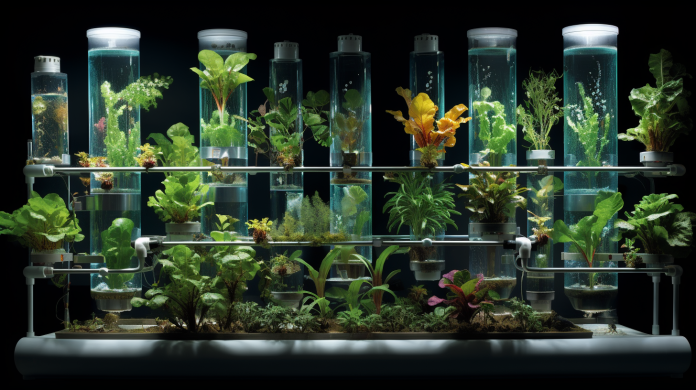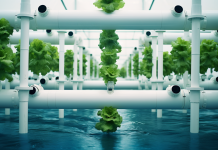Welcome to our guide on recirculating deep water culture (RDWC).
In this brief article, we will take a quick look at RDWC, from system setup to nutrient management, pH and EC level maintenance, and troubleshooting common issues.
Whether you are a seasoned hydroponic enthusiast or a novice looking to explore this efficient cultivation method, our exploration of RDWC may be of help you with some knowledge and insights.
The Basics of RDWC
RDWC, or Recirculating Deep Water Culture, is a popular method of growing plants hydroponically.
One of the advantages of RDWC is its ability to provide a constant supply of nutrient-rich water to the plants, promoting faster growth and higher yields. This system works by using a reservoir of water, which is continuously recirculated through the root zone of the plants.
The plants are suspended in net pots, with their roots submerged in the oxygenated water. This method is suitable for a wide range of plants, including leafy greens, herbs, and flowering plants.
However, it is important to note that larger plants with extensive root systems may require additional support to prevent them from becoming too heavy for the system.
Setting Up Your RDWC System
To begin setting up your RDWC system, gather all the necessary equipment and materials.
Here are three important steps to optimize your RDWC setup and maximize plant yield:
- Choose / or make the right nutrient solution: Investing in a high-quality nutrient solution specifically designed for hydroponic systems is crucial for maximizing plant yield. Look for a balanced formula that contains all the essential macro and micronutrients.
- Maintain proper pH levels: Regularly monitor and adjust the pH of your nutrient solution to optimize nutrient uptake. The ideal pH range for most plants in RDWC systems is between 5.5 and 6.5. Keeping the pH within this range ensures that nutrients are readily available to the plants.
- Provide adequate oxygenation: RDWC systems rely on oxygenated water to deliver nutrients to the roots. Using air stones or diffusers in the nutrient reservoir helps to increase oxygen levels, promoting healthy root growth and optimizing nutrient uptake.
Nutrient Management in RDWC
One key aspect of nutrient management in RDWC is ensuring proper nutrient balance and replenishment throughout the system. Nutrient deficiencies in RDWC can lead to stunted growth and reduced yields in plants.
To optimize nutrient uptake in RDWC, it is important to monitor and adjust nutrient levels regularly. This can be done by testing the nutrient solution and adjusting the nutrient concentration accordingly.
It is also important to ensure that the nutrient solution is well-oxygenated to promote healthy root development and nutrient absorption.
Additionally, maintaining the correct pH and Electrical conductivity (EC) levels in the RDWC system is crucial for nutrient uptake.
Maintaining Ph and EC Levels in RDWC
In order to ensure optimum nutrient uptake and plant health, it is imperative to maintain appropriate pH and Electrical conductivity (EC) levels in the RDWC system. Adjusting pH and EC levels in hydroponic systems is crucial for providing the ideal growing environment for plants.
Here are three important factors to consider when maintaining pH and EC levels in RDWC:
- Water quality: The quality of water used in the RDWC system plays a significant role in maintaining pH and EC levels. It is essential to use clean, filtered water that is free from contaminants and impurities.
- pH adjustment: Monitoring and adjusting pH levels is necessary to ensure that the nutrient solution remains within the optimal range for nutrient uptake. The ideal pH range for RDWC is typically between 5.5 and 6.5.
- EC management: Electrical conductivity (EC) measures the concentration of nutrients in the solution. Regular monitoring and adjustment of EC levels help maintain the desired nutrient concentration, preventing over or underfeeding of plants.
Electrical conductivity & Nutrients
Electrical conductivity (EC) is a crucial parameter in hydroponics because it helps determine the nutrient level and concentration in the hydroponic nutrient solution. EC is a measurement of the solution's ability to conduct electrical current, and it is directly related to the concentration of dissolved ions, including essential nutrients, in the water. Here's how EC helps determine nutrient levels in a hydroponic system:
Nutrient Concentration: EC is a reflection of the total concentration of dissolved ions in the nutrient solution. These ions primarily consist of essential nutrients like nitrogen (N), phosphorus (P), potassium (K), calcium (Ca), magnesium (Mg), and various micronutrients (e.g., iron, zinc, copper) that plants need for growth.
By measuring EC you can monitor the strength or concentration of the nutrient solution.
Troubleshooting Common Issues in RDWC
Common nutrient deficiencies can occur in RDWC systems due to various factors, such as improper nutrient solution formulation or inadequate nutrient uptake by the plants.
However, there are also common equipment problems that can arise in RDWC systems that may affect the overall health and growth of the plants.
One common issue is clogged or malfunctioning air stones or diffusers, which can lead to poor oxygenation of the nutrient solution. To maximize oxygenation, it is important to regularly clean and replace air stones or diffusers as needed.
Another common problem is leaks in the system, which can result in nutrient solution loss and imbalances. Regularly inspecting and maintaining all connections and fittings can help prevent leaks and ensure the system operates efficiently.
Key Takeaways
- RDWC is a popular hydroponic system that provides a constant supply of nutrient-rich water to plants.
- Proper nutrient balance and replenishment are crucial for optimal plant growth in RDWC.
- Maintaining pH and EC levels is important for nutrient uptake in RDWC.
- Regular maintenance and troubleshooting are necessary to prevent common issues in RDWC.
- Ideally you will need to invest in a ph meter and an EC meter.
Conclusion
In conclusion, recirculating deep water culture (RDWC) is a hydroponic system that allows plants to grow in a nutrient-rich water solution.
By continuously recirculating the water, RDWC provides a well-oxygenated environment for the plant roots, promoting optimal growth.
Proper nutrient management, pH, and EC level maintenance are crucial for successful RDWC cultivation.
Understanding and troubleshooting common issues in RDWC is essential for maximizing plant productivity and achieving desired results.
Please see our supporting articles:
The Basic Components of a DWC System
Hydroponics on a Budget: Affordable DIY

